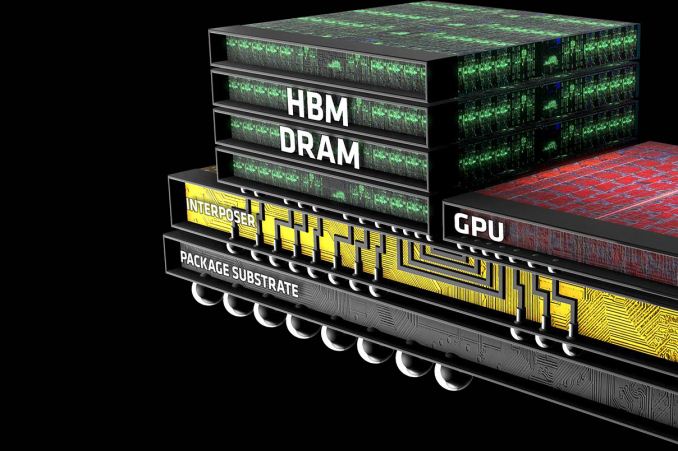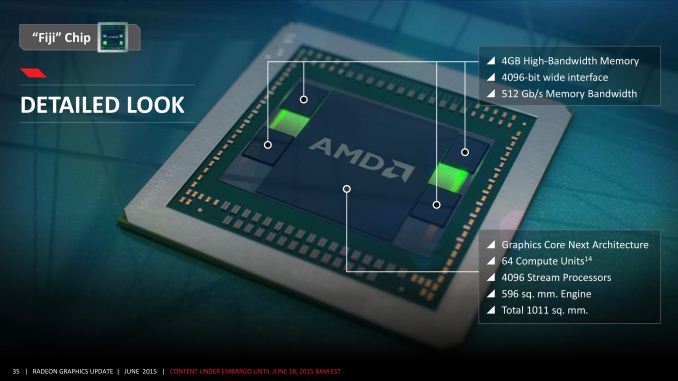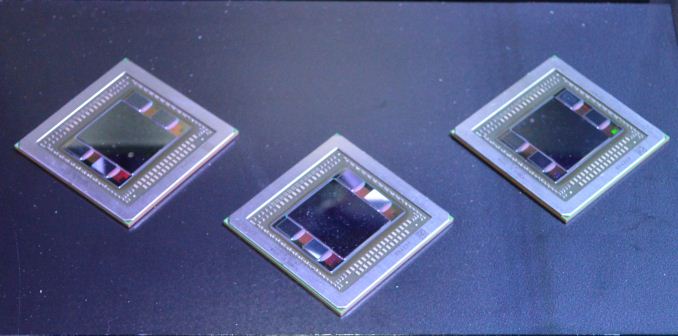The AMD Radeon R9 Fury X Review: Aiming For the Top
by Ryan Smith on July 2, 2015 11:15 AM ESTThe Fiji GPU: Go Big or Go Home
Now that we’ve had a chance to take a look at the architecture backing Fiji, let’s talk about the Fiji GPU itself.
Fiji’s inclusion of High Bandwidth Memory (HBM) technology complicates the picture somewhat when talking about GPUs. Whereas past GPUs were defined by the GPU die itself and then the organic substrate package it sits on, the inclusion of HBM requires a third layer, the silicon interposer. The job of the interposer is to sit between the package and the GPU, serving as the layer that connects the on-package HBM memory stacks with the GPU. Essentially a very large chip without any expensive logic on it, the silicon interposer allows for finer, denser signal routing than organic packaging is capable of, making the ultra-wide 4096-bit HBM bus viable for the first time.
We’ll get to HBM in detail in a bit, but it’s important to call out the impact of HBM and the interposer early, since they have a distinct impact on how Fiji was designed and what its capabilities are.
As for Fiji itself, Fiji is unlike any GPU built before by AMD, and not only due to the use of HBM. More than anything else, it’s simply huge, 596mm2 to be precise. As we mentioned in our introduction, AMD has traditionally shied away from big chips, even after the “small die” era ended, and for good reason. Big chips are expensive to develop, expensive to produce, take longer to develop, and yield worse than small chips (this being especially the case early-on for 40nm). Altogether they’re riskier than smaller chips, and while there are times where they are necessary, AMD has never reached this point until now.
The end result is that for the first time since the unified shader era began, AMD has gone toe-to-toe with NVIDIA on die size. Fiji’s 596mm2 die size is just 5mm2 (<1%) smaller than NVIDIA’s GM200, and more notably still hits TSMC’s 28nm reticle limit. TSMC can’t build chips any bigger than this; Fiji is as big a chip as AMD can order.
| AMD Big GPUs | ||||
| Die Size | Native FP64 Rate | |||
| Fiji (GCN 1.2) | 596mm2 | 1/16 | ||
| Hawaii (GCN 1.1) | 438mm2 | 1/2 | ||
| Tahiti (GCN 1.0) | 352mm2 | 1/4 | ||
| Cayman (VLIW4) | 389mm2 | 1/4 | ||
| Cypress (VLIW5) | 334mm2 | 1/5 | ||
| RV790 (VLIW5) | 282mm2 | N/A | ||
Looking at Fiji relative to AMD’s other big GPUs, it becomes very clear very quickly just how significant this change is for AMD. When Hawaii was released in 2013 at 438mm2, it was already AMD’s biggest GPU ever for its time. And yet Fiji dwarfs it, coming in at 158mm2 (36%) larger. The fact that Fiji comes at the latter-half of the 28nm process’s life time means that such a large GPU is not nearly as risky now as it would have been in 2011/2012 (NVIDIA surely took some licks internally on GK110), but still, nothing else we can show you today can really sell the significance of Fiji to AMD as much as the die size can.
And the fun doesn’t stop there. Along with producing the biggest die they could, AMD has also more or less gone the direction of NVIDIA and Maxwell in the case of Fiji, building what is unambiguously the most gaming/FP32-centric GPU the company could build. With GCN supporting power-of-two FP64 rates between 1/2 and 1/16, AMD has gone for the bare minimum in FP64 performance that their architecture allows, leading to a 1/16 FP64 rate on Fiji. This is a significant departure from Hawaii, which implemented native support for ½ rate, and on consumer parts offered a handicapped 1/8 rate. Fiji will not be a FP64 powerhouse – its 4GB of VRAM is already perhaps too large of a handicap for the HPC market – so instead we get AMD’s best FP32 GPU going against NVIDIA’s best FP32 GPU.
AMD’s final ace up their sleeve on die size is HBM. Along with HBM’s bandwidth and power benefits, HBM is also much simpler to implement, requiring less GPU space for PHYs than GDDR5 does. This is in part due to the fact that HBM stacks have their own logic layer, distributing some of the logic on to each stack, and furthermore a benefit of the fact that the signaling logic that remains doesn’t have to be nearly as complex since the frequencies are so much lower. 4096-bits of HBM PHYs still takes up a fair bit of space – though AMD won’t tell us how much – but it’s notably lower than the amount of space AMD was losing to Hawaii’s GDDR5 memory controllers.
The end result is that not only has AMD built their biggest GPU ever, but they have done virtually everything they can to maximize the amount of die space they get to allocate to FP32 and rendering resources. Simply put, AMD has never reached so high and aimed for parity with NVIDIA in this manner.
Ultimately this puts Fiji’s transistor count at 8.9 billion transistors, even more than the 8 billion transistors found in NVIDIA’s GM200, and, as expected, significantly more than Hawaii’s 6.2 billion. Interestingly enough, on a relative basis this is almost exactly the same increase we saw with Hawaii; Fiji packs in 43.5% more transistors than Hawaii, and Hawaii packed in 43.9% more transistors than Tahiti. So going by transistors alone, Fiji is very much to Hawaii what Hawaii was to Tahiti.
Finally, as large as the Fiji GPU is, the silicon interposer it sits on is even larger. The interposer measures 1011mm2, nearly twice the size of Fiji. Since Fiji and its HBM stacks need to fit on top of it, the interposer must be very large to do its job, and in the process it pushes its own limits. The actual interposer die is believed to exceed the reticle limit of the 65nm process AMD is using to have it built, and as a result the interposer is carefully constructed so that only the areas that need connectivity receive metal layers. This allows AMD to put down such a large interposer without actually needing a fab capable of reaching such a large reticle limit.
What’s interesting from a design perspective is that the interposer and everything on it is essentially the heart and soul of the GPU. There is plenty of power regulation circuitry on the organic package and even more on the board itself, but within the 1011mm2 floorplan of the interposer, all of Fiji’s logic and memory is located. By mobile standards it’s very nearly an SoC in and of itself; it needs little more than external power and I/O to operate.













458 Comments
View All Comments
anandreader106 - Thursday, July 2, 2015 - link
@Wreckage Not quite. Cash reserves play a role in evaluating a company's net worth. When AMD acquired ATI, they spent considerable money to do so and plunged themselves into debt. The resulting valuation of AMD was not simply the combined valuations of AMD and ATI pre-acquisition. Far from it.AMD is the undisputed underdog in 2015, and has been for many years before that. That is why Ryan gave so much praise to AMD in the article. For them to even be competitive at the high end, given their resources and competition, is nothing short of impressive.
If you cannot at least acknowledge that, than your view on this product and the GPU market is completely warped. As consumers we are all better off with a Fury X in the market.
Yojimbo - Thursday, July 2, 2015 - link
Yes, NVIDIA was definitely the underdog at the time of the AMD purchase of ATI. Many people were leaving NVIDIA for dead. NVIDIA had recently lost its ability to make chipsets for Intel processors, and after AMD bought ATI it was presumed (rightly so) that NVIDIA would no longer be able to make chipsets for AMD processors. It was thought that the discrete GPU market might dry up with fusion CPU/GPU chips taking over the market.chizow - Thursday, July 2, 2015 - link
Yep, I remember after the merger happened most AMD/ATI fans were rejoicing as they felt it would spell the end of both Nvidia and Intel, Future is Fusion and all that promise lol. Many like myself were pointing out the fact AMD overpayed for ATI and that they would collapse under the weight of all that debt given ATI's revenue and profits didn't come close to justifying the purchase price.My how things have played out completely differently! It's like the incredible shrinking company. At this point it really is in AMD and their fan's best interest if they are just bought out and broken up for scraps, at least someone with deep pockets might be able to revive some of their core products and turn things around.
Ranger101 - Friday, July 3, 2015 - link
Well done Mr Smith. I would go so far as to say THE best Fury X review on the internet barnone. The most important ingredient is BALANCE. Something that other reviews sorely lack.
In particular the PCPer and HardOCP articles read like they were written by the green
goblin himself and consequently suffer a MASSIVE credibility failure.
Yes Nvidia has a better performing card in the 980TI but it was refreshing to see credit
given to AMD where it was due. Only dolts and fanatical AMD haters (I'm not quite sure
what category chizow falls into, probably both and a third "Nvidia shill") would deny that
we need AMD AND Nvidia for the consumer to win.
Thanks Anandtech.
Michael Bay - Friday, July 3, 2015 - link
Except chizow never stated he wishes to see AMD dead.I guess it`s your butthurt talking.
chizow - Friday, July 3, 2015 - link
Yep, just AMD fanboys ;)"What's Left of AMD" can keep making SoCs and console APUs or whatever other widgets under the umbrella of some monster conglomerate like Samsung, Qualcomm or Microsoft and I'm perfectly OK with that. Maybe I'll even buy an AMD product again.
medi03 - Sunday, July 5, 2015 - link
"AMD going away won't matter to anyone but their few remaining devout fanboys'So kind (paid?) nVidia troll chizow is.
chizow - Monday, July 6, 2015 - link
@medi03 no worries I look forward to the day (unpaid?) AMD fantroll's like you can free yourselves from the mediocrity that is AMD.chizow - Friday, July 3, 2015 - link
Yet, still 3rd rate. The overwhelming majority of the market has gone on just fine without AMD being relevant in the CPU market, and recently, the same has happened in the GPU market. AMD going away won't matter to anyone but their few remaining devout fanboys like Ranger101.piiman - Friday, July 3, 2015 - link
"AMD going away won't matter to anyone but their few remaining devout fanboys'Hmmm you'll think different when GPU prices go up up up. Competition is good for consumers and without it you will pay more, literally.